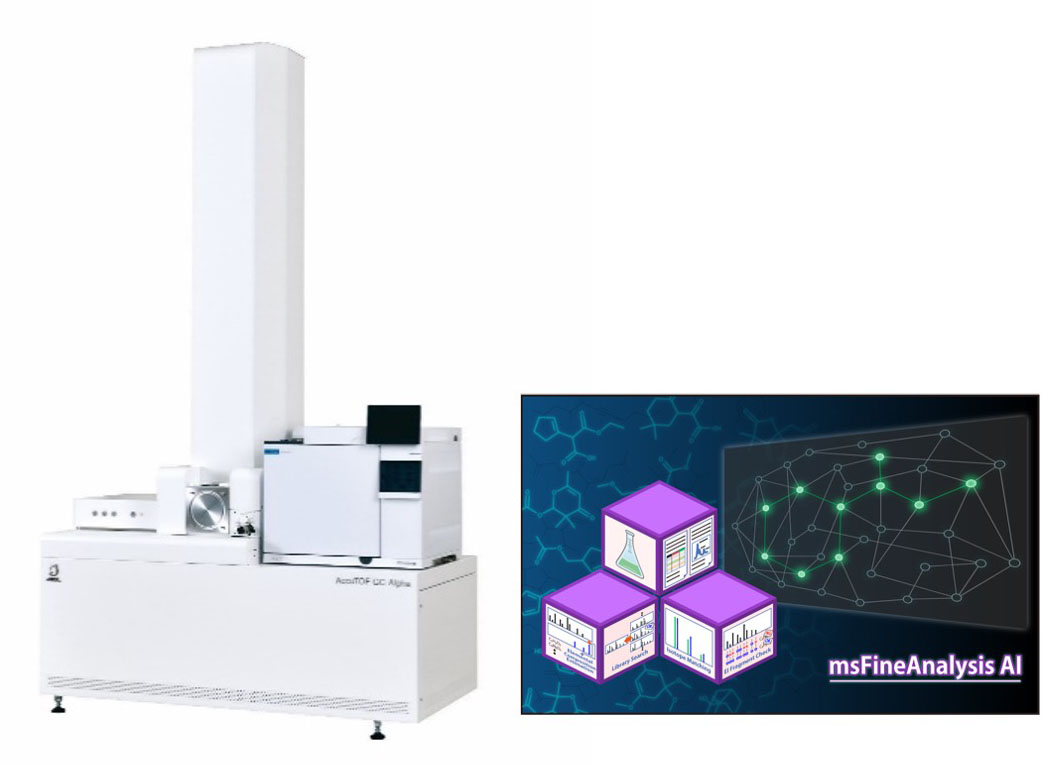Structural analysis of contaminant in polypropylene product using msFineAnalysis AI
MSTips No.424
Introduction
Polypropylene has high strength, heat resistance, and excellent workability, so it is used in many industrial products. In the process of productization, material pellets are pulverized, mixed, and molded. Contaminants mixed in these processes causes deterioration in product performance. Pyrolysis-GC-MS method is generally used to identify contaminants, but most of pyrolysis products are not registered in the mass spectra library. So it is difficult to obtain satisfactory results with qualitative analysis relying on library searches. Time-of-flight mass spectrometer JMS-T2000GC and unknown compounds structure analysis software msFineAnalysis AI are effective for qualitative analysis of these unregistered compounds (=unknown compounds). Previous report MSTips No.330 introduced molecular formula derivation by EI/SI integrated analysis for contaminant in polypropylene product. This MSTips introduces structural formula derivation by AI structural analysis.
Experiment

JMS-T2000GC, msFineAnalysis AI
Using (A) normal product and (B) defective products of polypropylene as samples, measurement was performed by the Pyrolysis-GC-MS method. The sample amounts were 0.2 mg for the EI method and 1.0 mg for the FI method. The repeat number of measurements for variance component analysis were n=5 for the EI method and n=1 for the FI method. The peaks specific to (B) defective product were derived by variance component analysis mode of msFineAnalysis AI. And their molecular and structural formulas were derived. Table 1 shows the measurement and analysis conditions.
Table 1 Measurement and analysis conditions

TIC chromatograms of EI method
Figure 1 shows the TIC chromatograms of EI method. Chromatograms shapes of (A) normal product and (B) defective product were similar, but a large difference peak was detected around 5 min for the (B) defective product. This peak was derived as styrene by library search.

Figure 1 TIC chromatograms of EI method
Volcano plot of variance component analysis
Figure 2 shows the volcano plot of variance component analysis. Each plot corresponds to a peak on the chromatogram, and visually expresses the difference with the intensity ratio on the horizontal axis and the statistical significance (repeatability) on the vertical axis. In this analysis, 82 peaks with an intensity ratio of up to 2% to the maximum peak were targeted, and 12 peaks specific to (B) defective product were extracted.

Figure 2 Volcano plot
Qualitative analysis results of peaks specific to (B) defective product
Table 2 shows the qualitative results of peaks specific to (B) defective product. The compound names and structural formulas of the row which the cell "LIB." is "mainlib" are derived by NIST library search. And these of "AI" are derived by AI structural analysis. Library search derived only for 3 peaks, but AI structure analysis derived for the remaining 9 peaks.
Table 2 Qualitative analysis results of peaks specific to (B) defective product

Figure 3 shows a list of derived structural formulas. Structures of all ID023-050 suggests hybrid dimers and trimers of AS copolymers, and agree with the reference literature with high accuracy 1). So it was possible to identify that the contaminant mixed in (B) defective product was the AS copolymer.

Figure 3 Structural formula of peaks specific to (B) defective product
Conclusion
Using JMS-T2000GC and msFineAnalysis AI, it was possible to identify that the contaminant of (B) defective product of polypropylene was AS copolymer. Many of the pyrolysis products are not registered in the mass spectral library, especially for copolymers such as AS. JMS-T2000GC and msFineAnalysis AI are effective for these analyses.
Reference
1) Shin Tsuge, Hajime Ohtani, Chuichi Watanabe (2011), Pyrolysis - GC/MS Data Book of Synthetic Polymers, Elsevier
Solutions by field
Related products
Are you a medical professional or personnel engaged in medical care?
No
Please be reminded that these pages are not intended to provide the general public with information about the products.


